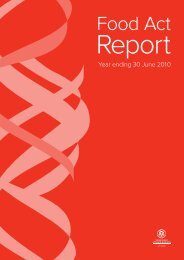Public Health and Communicable Diseases - SA Health - SA.Gov.au
Public Health and Communicable Diseases - SA Health - SA.Gov.au
Public Health and Communicable Diseases - SA Health - SA.Gov.au
You also want an ePaper? Increase the reach of your titles
YUMPU automatically turns print PDFs into web optimized ePapers that Google loves.
InfluenzaSouth Australian influenza surveillance combineslaboratory-confirmed cases reported by the Institute ofMedical <strong>and</strong> Veterinary Science <strong>and</strong> South Path, withclinical diagnoses of ‘influenza-like illness’ collected bythe Royal College of General Practitioners membersparticipating in the Australian Sentinel Practice Network,<strong>and</strong> emergency departments of several public hospitals.In the period under review, there were 167 influenza A<strong>and</strong> 49 influenza B laboratory isolates reported.The strains from South Australia typed in 2005 by theWHO Collaborating Centre for Reference <strong>and</strong> Researchon Influenza (www.influenzacentre.org) were mainlyA/H3/California/7/2004-like <strong>and</strong> B/Shanghai/361/2002-like. There have also been positive cultures of A/H3/Wellington/1/2004-like, B/Hong Kong/330/2001-like <strong>and</strong>A/H1/New Caledonia/20/99-like.Invasive pneumococcal diseaseThere were 76 cases of pneumococcal disease reportedduring this period (37 males, 39 females, age range: 8months to 92 years). Four of the cases were indigenous.Eight (11%) cases were notified in children less than fiveyears of age. Four deaths were linked to this disease.GASTROINTESTINAL DISEASESCampylobacterCampylobacter infection remains the most commonlyreported notifiable disease in South Australia. In theperiod under review, 1238 notifications were receivedfor residents of metropolitan Adelaide <strong>and</strong> rural SouthAustralia. This compares with 1079 cases notified duringthe corresponding period in 2004.A cluster of 14 cases of Campylobacter infection wasassociated with a school in metropolitan Adelaide.An analytical study showed a significant associationbetween illness <strong>and</strong> eating a meal at the school. Thesource of the illness was not identified.CryptosporidiosisSixty three cases were reported (31 males, 32 females,age range: 1 month to 81 years). No clusters oroutbreaks were identified.Hepatitis AIn the period under review there were seven cases ofhepatitis A notified. Four of the seven cases were partof a cluster that was investigated by the <strong>Communicable</strong>Disease Control Branch. Three of the four (two males,two females, age range: 7 to 52 years) cases resided in aremote South Australian town <strong>and</strong> the other resided in aneighbouring town. Two cases were indigenous. No directcontact between the four cases could be established.<strong>Health</strong> information <strong>and</strong> an exp<strong>and</strong>ed immunisationprogram were implemented in the local area.42The other three cases (three males, age range: 43 to 57years) reported recent overseas travel to endemic areasfor hepatitis A infection <strong>and</strong> interstate travel.ListeriosisFive cases of listeriosis were notified in the reportingperiod (three females, two males, age range: 53 to 73years). One of the cases was Listeria monocytogenesserogroup 4 <strong>and</strong> four cases were Listeriamonocytogenes serogroup 1.The four Listeria moncytogenes serogroup 1 cases wereinvestigated as a cluster. Prior to illness onset all caseshad admissions to one or several health care facilities.Three had underlying immuno-compromising illnesses<strong>and</strong> two died. Results of molecular typing established alink between contaminated food <strong>and</strong> illness in two casesassociated with one particular health care facility. Theremaining two cases had molecular typing different fromeach other <strong>and</strong> different from the common strain sharedby the contaminated food <strong>and</strong> the two cases associatedwith a particular health care facility.ShigellosisThere were 30 cases of shigellosis reported (11 males,19 females). Of these, Shigella flexneri type 4a mannitolnegative <strong>and</strong> Shigella sonnei biotype g were the mostfrequently reported species.Transmission of Shigella flexneri type 4a mannitolnegative was associated with living in remotecommunities in South Australia. In total, eight caseswere reported (three males, five females, age range: 4to 68 years); seven of these were indigenous.Eight cases of Shigella sonnei biotype g infection werenotified during this period (four males, four females,age range: 5 to 67 years). Six cases reported recentoverseas travel.Shiga toxin producing Escherichia coliThirteen cases were reported during the period underreview (five males, eight females, age range: 8 to90 years). The majority of cases were residents ofmetropolitan Adelaide. No common exposure or sourceof illness was identified among the cases.SalmonellosisIn the period under review, 294 cases of salmonellosiswere reported. The most commonly reported wereSalmonella Typhimurium phage type 64 (44 cases),Salmonella Typhimurium phage type 44 (29 cases),Salmonella Infantis (23 cases), Salmonella Typhimuriumphage type 9 (14 cases), Salmonella Typhimurium phagetype 108 (13 cases), Salmonella Typhimurium phage type135a (12 cases) <strong>and</strong> Salmonella Typhimurium phage type135 (11 cases).
















